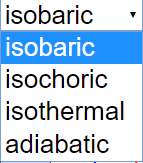About
The pressure-volume conjugate pair is concerned with the transfer of mechanical or dynamic energy as the result of work.
* An isobaric process occurs at constant pressure. An example would be to have a movable piston in a cylinder, so that the pressure inside the cylinder is always at atmospheric pressure, although it is isolated from the atmosphere. In other words, the system is dynamically connected, by a movable boundary, to a constant-pressure reservoir.
* An isochoric process is one in which the volume is held constant, meaning that the work done by the system will be zero. It follows that, for the simple system of two dimensions, any heat energy transferred to the system externally will be absorbed as internal energy. An isochoric process is also known as an isometric process or an isovolumetric process. An example would be to place a closed tin can containing only air into a fire. To a first approximation, the can will not expand, and the only change will be that the gas gains internal energy, as evidenced by its increase in temperature and pressure. Mathematically, ?Q = dU. We may say that the system is dynamically insulated, by a rigid boundary, from the environment.
The temperature-entropy conjugate pair is concerned with the transfer of thermal energy as the result of heating.
* An isothermal process occurs at a constant temperature. An example would be to have a system immersed in a large constant-temperature bath. Any work energy performed by the system will be lost to the bath, but its temperature will remain constant. In other words, the system is thermally connected, by a thermally conductive boundary to a constant-temperature reservoir.
* An adiabatic process is a process in which there is no energy added or subtracted from the system by heating or cooling. For a reversible process, this is identical to an isentropic process. We may say that the system is thermally insulated from its environment and that its boundary is a thermal insulator. If a system has an entropy which has not yet reached its maximum equilibrium value, the entropy will increase even though the system is thermally insulated.
The following let you play with different processes:
The work done, heat transfer, internal energy as well as entropy change will be shown when you change parameter with slider bar.
Translations
| Code | Language | Translator | Run | |
|---|---|---|---|---|
 |
||||
Software Requirements
| Android | iOS | Windows | MacOS | |
| with best with | Chrome | Chrome | Chrome | Chrome |
| support full-screen? | Yes. Chrome/Opera No. Firefox/ Samsung Internet | Not yet | Yes | Yes |
| cannot work on | some mobile browser that don't understand JavaScript such as..... | cannot work on Internet Explorer 9 and below |
Credits


Fu-Kwun Hwang; Fremont Teng; Loo Kang Wee
Sample Learning Goals
[text]
For Teachers
Pressure Volume Diagram JavaScript Simulation Applet HTML5
Instructions
Combo Box for Mode
Toggling the various options give you their respective modes of simulation.
(Isobaric allows you to drag the ball only horizontally)
(Isochoric only allows horizontal dragging)
(Isothermal and Adiabatic allow diagonal dragging but with different steepness.)
Draggable Point
This can be done so by dragging the centre of the ball.
They will then give you the respective data about it on the top left and
bottom right corners of the simulations.
Pressure, Volume and Temperature Sliders
Slide through the respective sliders to alter the variables.
Note that in some modes, the sliders will be unusable.
Toggling Full Screen
Double clicking anywhere on the panel to toggle full screen.
Reset Button
Resets the simulation.
Research
[text]
Video
[text]
Version:
Other Resources
- PV diagram for an Ideal Gas https://www.geogebra.org/m/xyqhfvyw by Tan Seng Kwang
end faq
{accordionfaq faqid=accordion4 faqclass="lightnessfaq defaulticon headerbackground headerborder contentbackground contentborder round5"}
- Details
- Written by Fremont
- Parent Category: 13 Thermodynamic Systems
- Category: 04 Thermal Properties of Matter
- Hits: 4921


.png
)






